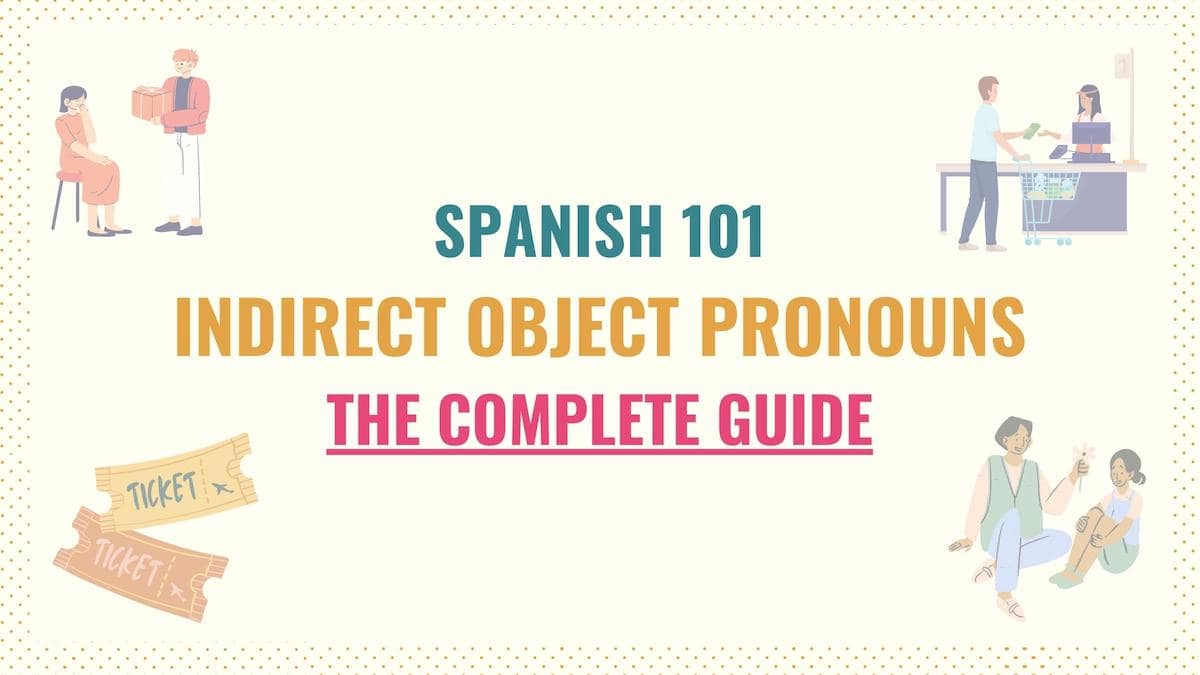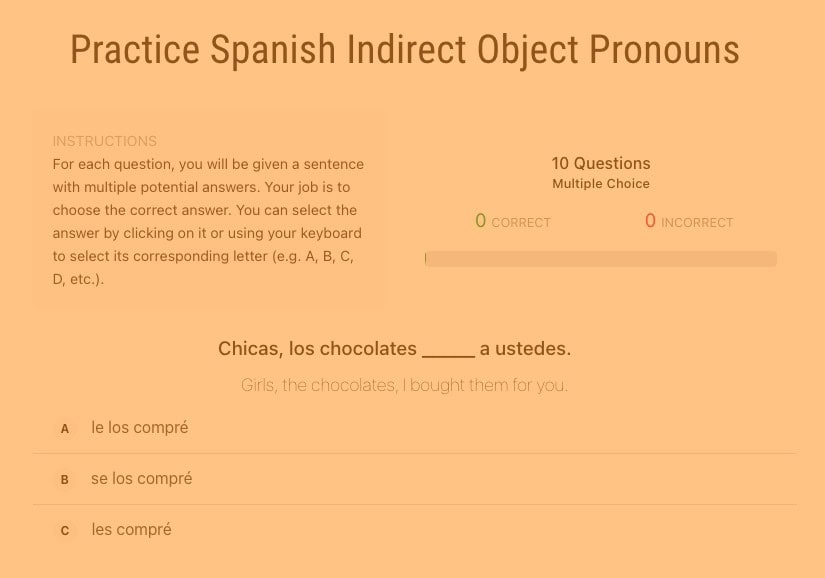When learning Spanish, you’ve likely seen or used the pronouns me, te, le, nos, and les. These are Spanish indirect object pronouns and are an essential part of speech. Simply put, indirect pronouns can help you sound more fluent because they make your sentences clearer and shorter.
So, in this guide, we’ll learn how to use these pronouns. Here is an overview of what we’ll cover:
- What Are the Spanish Indirect Object Pronouns
- How to Use Indirect Object Pronouns
- Indirect Object Pronouns with Verbs Like ‘Gustar’
- Order of Indirect Object Pronouns in Spanish
- Verbs that Take Indirect Objects
- Bonus: Using the Indirect Object Pronoun Se Instead of Le
- Key Points
- Downloadable PDF
- Practice Quiz
Let’s do this, shall we?
List of Indirect Object Pronouns in Spanish
In Spanish, there are six main indirect object pronouns with an alternate seventh:
- Me – Me
- Te – You (informal you)
- Le (se*) – Him / Her / It / You (formal)
- Nos – Us
- Os – You (plural, Castilian)
- Les (se)* – Them / You (plural)
*Note: The pronoun se is only used to replace le or les in sentences with double object pronouns. In other words, when a sentence contains both third-person direct (lo, la, los, las) and indirect object pronouns, we must use se instead of ‘le’ or ‘les’. This change is made for semantic purposes.
How to Use Spanish Indirect Object Pronouns
Like any other Spanish pronoun, indirect object pronouns (sometimes abbreviated as IOPs) have a simple purpose: replacing an element within a sentence. Indirect object pronouns substitute the indirect object.
So, what is an indirect object in Spanish, and how do you find it?
In Spanish, the indirect object is the part of the sentence affected or benefited by someone’s (the subject) action. Put another way, the indirect object is the person or thing to or for whom the action is done.
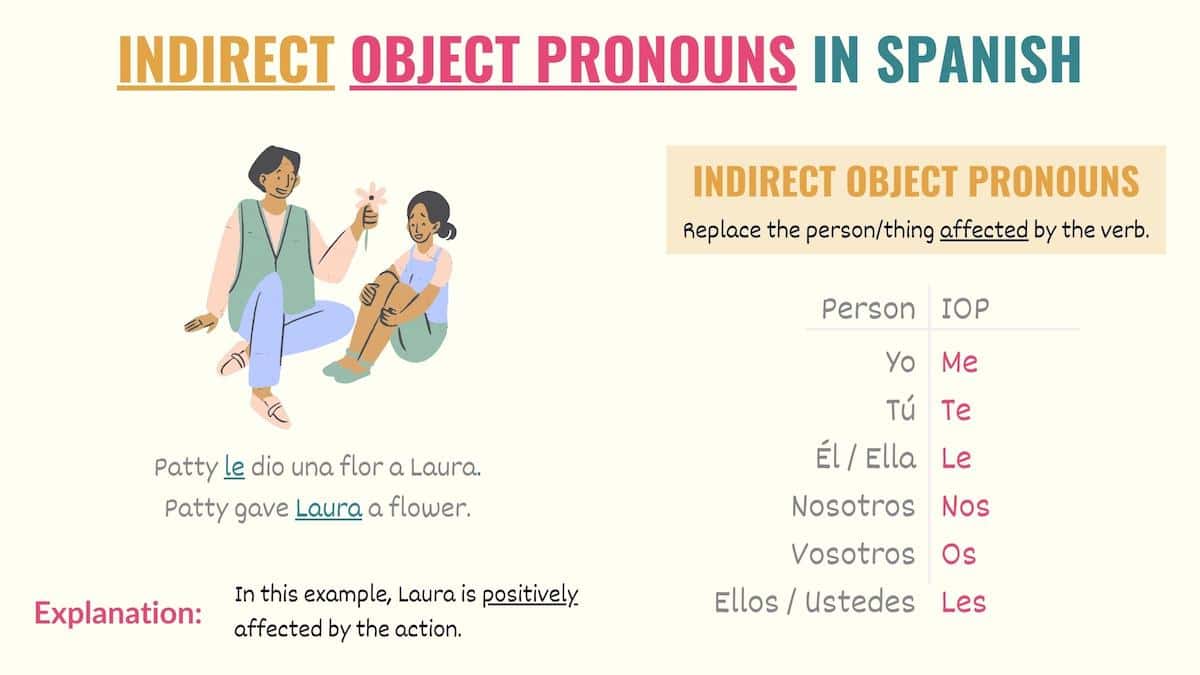
Spanish indirect objects can be a noun, a noun phrase or a prepositional pronoun. To find it, you combine the questions “for whom” or “to whom” with the verb in your sentence. Let’s check these examples:
Joe enseña a los niños a contar.
Joe teaches the kids to count.
So, to find the indirect object in this sentence, we ask ‘to whom Joe teaches?’. The answer is to the kids. This means the sentence can use a plural indirect object pronoun:
Joe les enseña.
Joe teaches them.
Here is another example:
Charlie compró esos chocolates para mí.
Charlie bought those chocolates for me.
‘For whom Charlie bought those chocolates?’. Para mí (for me). So, here is how that sentence will look when replacing the indirect object:
Charlie me compró esos chocolates.
Charlie bought me those chocolates.
KEY TIP: Check the example above. It also has a direct object (chocolates). Like this example, many Spanish sentences contain both types of objects. When this happens, you can find the indirect object by identifying the person or thing that receives the direct object.
Le dije a Juan – Indirect object pronoun duplication
Le and les are the Spanish indirect objects for the third person. They replace both feminine and masculine nouns (things or people). Since they can refer to many things, le and les can be ambiguous if there’s no background information.
To avoid this confusion, many Spanish sentences use double indirect objects. This means that, instead of replacing, we use the indirect object and the pronoun together to provide more clarification:
Le regalé un libro a mi hermano.
I bought my brother a book.
Sonia le dijo a Juan de la fiesta.
Sonia told Juan about the party.
Indirect Object Pronouns & Verbs Like Gustar
Affective verbs in Spanish (verbs like ‘gustar’) convey that a thing or activity affects a person. Because of this, their conjugation always uses an indirect object pronoun:
A Leticia le gustan los perros.
Leticia likes dogs.
A mí me molesta el ruido.
The noise bothers me.
Este teléfono nos costó mucho dinero.
This phone cost us a lot of money.
At first glance, affective verbs may seem odd. But in fact, affective verbs (verbs like gustar) are part of the set of verbs that take indirect object pronouns. They have:
- A subject: the thing or action that causes a feeling (such as dogs in example #1)
- A verb: the feeling (to like, for example)
- Indirect object: the person affected by the verb (Leticia)
Take Note: Structures with affective verbs may not always have a direct translation in English. Check this list with common verbs like gustar to find affective verbs you’ll use in daily situations.
Order of Indirect Object Pronouns in Spanish
The correct order of indirect object pronouns in Spanish is:
- Before a conjugated verb
[Indirect object pronouns] + [conjugated verb]
Le pedí dinero a Carlos.
I asked Carlos for money.
No nos has dicho qué hacer.
You haven’t told us what to do.
- Attached to affirmative commands, infinitive verbs, or gerunds:
Dame mi teléfono.
Give me my phone.
Quiero decirte que lo siento.
I want to tell you that I’m sorry.
Except for the perfect tenses, you have some flexibility with sentences with more than one verb. In other words, with these types of structures, you can either place the pronoun before the conjugated verb or attach it to the infinitive or gerund. Both examples below are correct applications of where to place the indirect object pronoun:
Le voy a decir mañana.
I’m going to tell her tomorrow.
Voy a decirle mañana.
I’m going to tell her tomorrow.
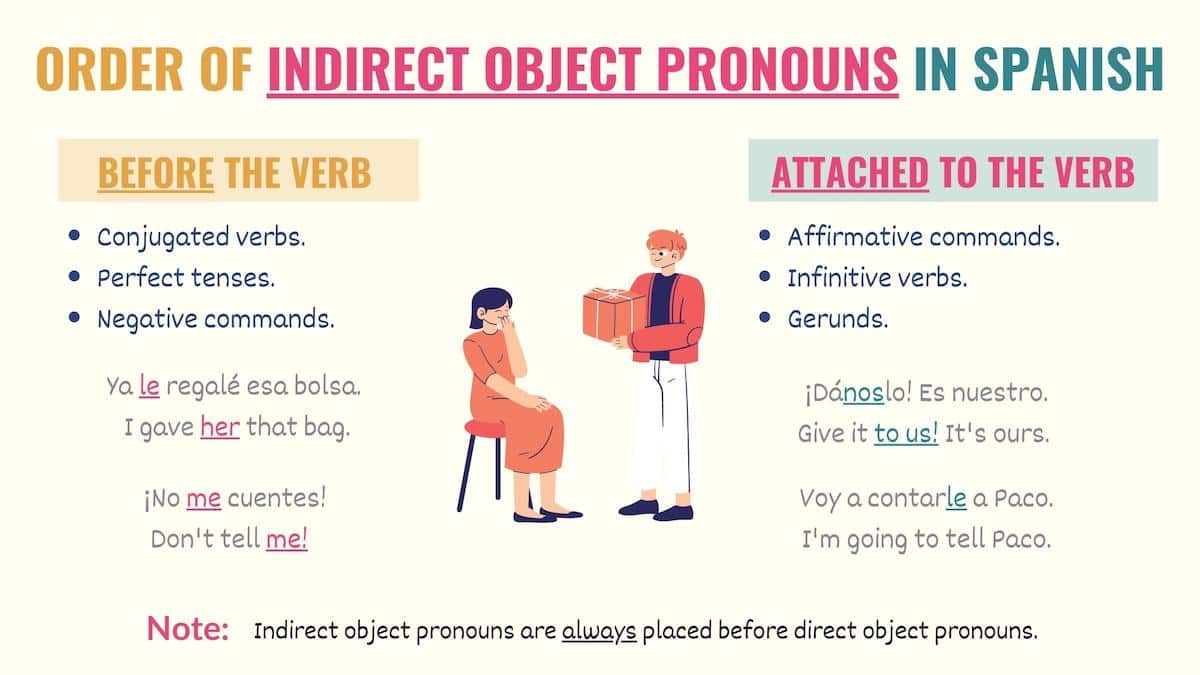
Take Note: Some sentences may use both indirect and direct object pronouns (called double object pronouns). In these cases, both pronouns must follow the previous placement rules. However, the indirect object pronoun always goes before the direct object pronoun.
Dámela, por favor.
Give it to me, please.
Se los envié a Carlos.
I sent them to Carlos.
Verbs that Take Indirect Objects in Spanish
In Spanish, there are many verbs that can work with indirect objects. However, some of the most common Spanish verbs that take indirect objects are:
- Aconsejar – To give advice
- Advertir – To warn
- Avisar – To warn / To advise
- Comprar – To buy
- Contar – To tell
- Dar – To give
- Decir – To tell / To say
- Enseñar – To teach
- Explicar – To explain
- Hablar – To talk / To speak
- Interesar – To interest
- Gustar – To like
- Mandar – To send
- Marcar – To call
- Mentir – To lie
- Molestar – To bother
- Pagar – To pay
- Pasar – To pass
- Pegar – To hit
- Prestar – To borrow / To lend
- Quitar – To take from
- Recomendar – To recommend
- Traer – To bring
Take Note: Be aware that some of these verbs may also take a direct object. Sometimes, using direct or indirect object pronouns slightly changes the sentence’s meaning. For example –Yo los pagué (you paid something) vs Yo les pagué (you paid someone).
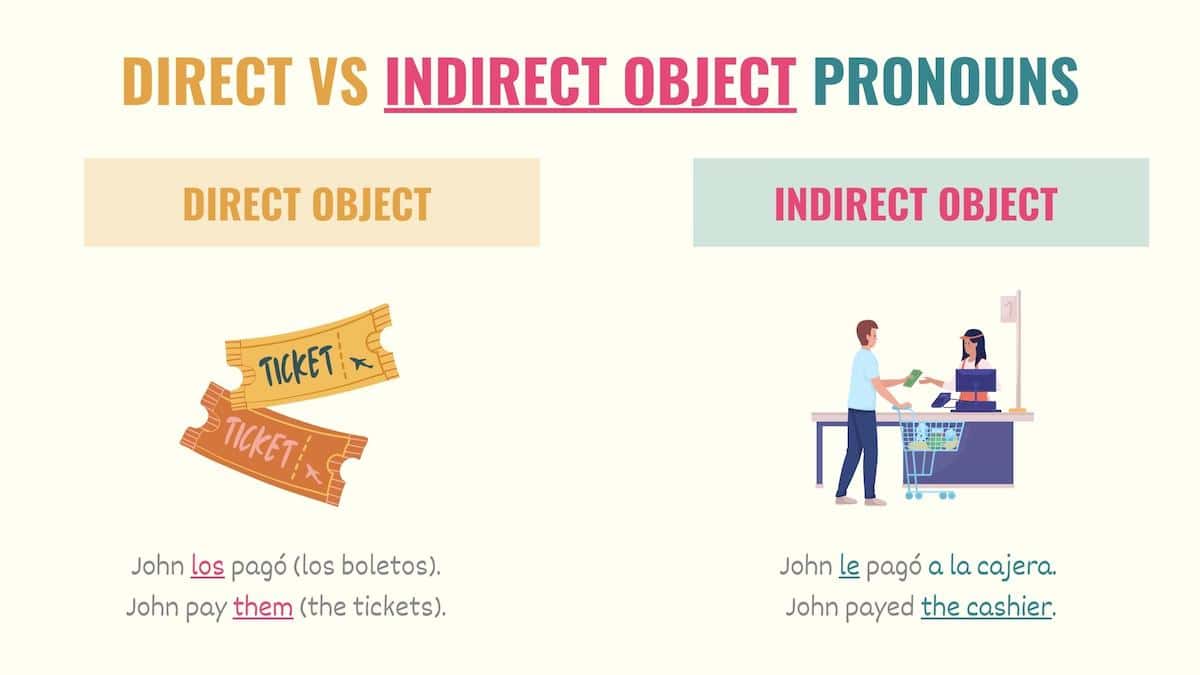
Using the Indirect Object Pronoun Se Instead of Le
When replacing an indirect object, le and se are the same pronoun. Se is used instead of ‘le’ only if a sentence has both third-person direct and indirect object pronouns.
Incorrect
Compré unas flores y le las regalé a Joy.
I bought some flowers and gave them to Joy.
Correct
Compré unas flores y se las regalé a Joy.
I bought some flowers and gave them to Joy.
Using se instead of le and les is done for semantic purposes. This is because lelo as well as its feminine and plural forms mean ‘dumb’ in Spanish.
Take Note: In some sentences, the pronoun se may work as a reflexive pronoun. In this case, se communicates that someone is performing an action upon himself or herself. If you were performing the action on another person, you should use an indirect object pronoun:
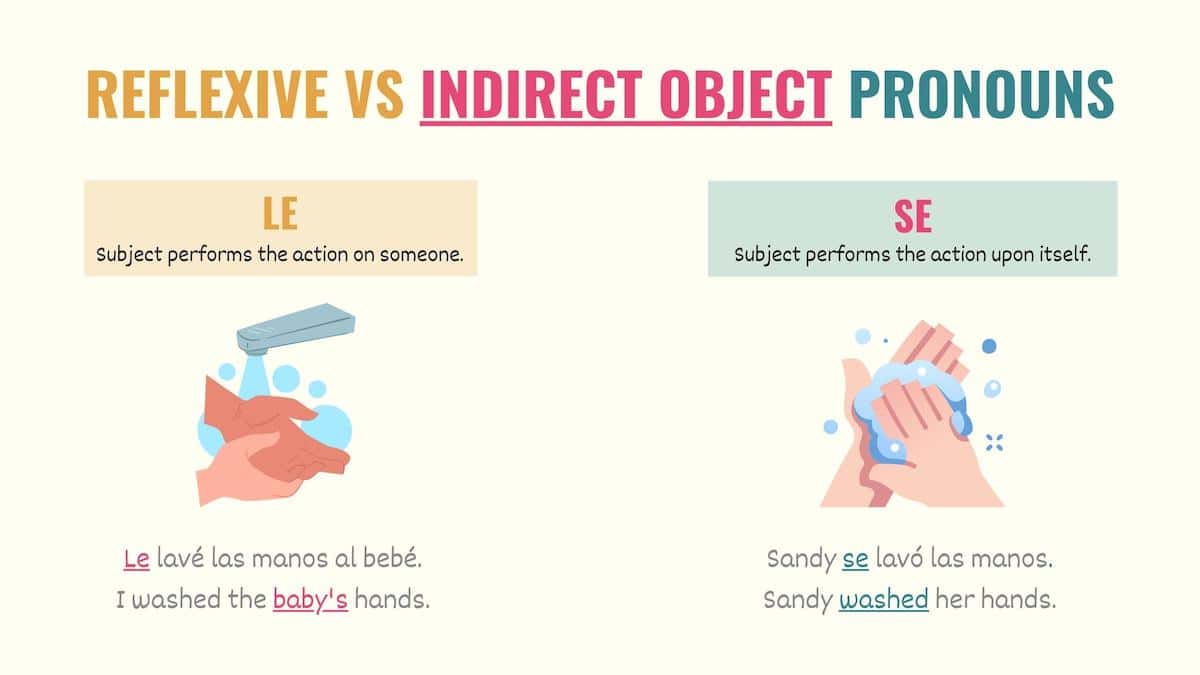
Key Points
Indirect object pronouns in Spanish are crucial to speak naturally and fluidly. Here are the key points to know:
- Spanish indirect object pronouns are me, te, le, nos, os, les.
- The pronoun se replaces le/les in sentences which also contain third-person direct object pronouns.
- An indirect object is the part of the sentence affected or benefited by the subject’s action.
- The indirect object responds to the questions ‘for whom’ or ‘to whom’ (a quién or para quién) an action is performed.
- Spanish indirect object pronouns must be placed before the conjugated verb in sentences with one verb, negative commands, or when using perfect tenses.
- Indirect object pronouns must be attached to affirmative commands, infinitives, and present participles.
- The indirect object pronouns always come before direct object pronouns.
Download the Spanish Indirect Object Pronouns Cheat sheets PDF
Learning how to use the Spanish indirect object pronoun is one of the hardest topics in the Spanish language. So, I’ve created a downloadable PDF with the cheat sheets for this guide, including the graphics, rules, examples, and key points you need to revisit this subject whenever you need a refresher.
Practice Quiz
If you want to practice indirect object pronouns, you should take this quiz. ¡Buena suerte!

